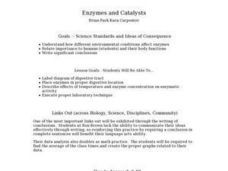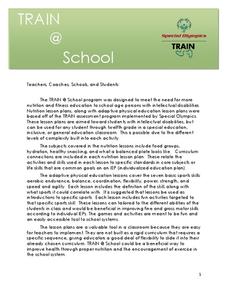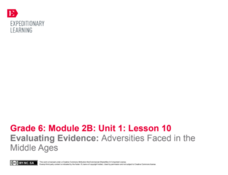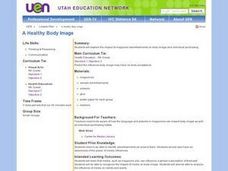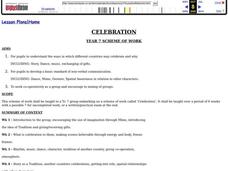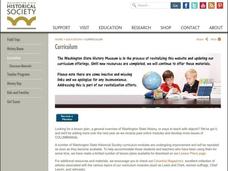Curated OER
Mr. Lincoln's Whiskers
Students compose a letter to a family member. In this writing lesson, students listen to the book, Mr. Lincoln's Whiskers and identify the parts of a letter.
Curated OER
Newspapers
Have your class learn about the features of a newspaper. Learners identify the parts of a newspaper and an article. They discuss the elements of good writing and describe how to add photos and captions to a story. Informative and...
Curated OER
Recognizing Types of Sentences
Examine eleven sentences and identify them as simple sentences, compound sentences, or complex sentences in this grammar activity. Use the activity as a quiz, review lesson, or homework assignment.
Curated OER
A Tree Grows in Brooklyn
In this story structure lesson, students read the book A Tree Grows in Brooklyn and identify the characters, setting and main themes of the book. They answer a list of study questions about the book.
Curated OER
Shizuko’s Daughter: Question Answer Relationships
Asking questions about what you're reading is an effective way to connect with the text. After kids read passages from Kyoko Mori's Shizuko's Daughter, they identify questions about the passages as Right There, Think and...
Curated OER
Hamlet 1.2: Hamlet's First Soilloquy
O, that these too, too obscure words would resolve themselves into modern English! High school scholars are asked to do a close reading of Hamlet’s first soliloquy (I, ii) and recast these famous lines into contemporary speech, identify...
Curated OER
Using Words to Work Things Out
Students explore appropriate ways to communicate feelings. In this character development instructional activity, students listen to Hands are not for Hitting and several other books about expressing emotions appropriately. ...
Curated OER
Enzymes and Catalysts
Students discuss the functioning of the digestive system and the specific enzymes present. They observe the action of amylase on starch to identify characteristics of enzymes then perform an experiment on the effects of temperature on...
Curated OER
If I Were An Animal
Students choose a favorite animal and identify its prominent characteristics. They draw their favorite animal adding their own heads to animal bodies. Then they write a creative, detailed short story about themselves as a nonsense creature.
Curated OER
Parts of a Friendly Letter
The art of writing a letter has not been lost to email and texting! Teach kids how to format a friendly letter with a presentation about the parts of a letter, as well as prompting them to write a letter about their favorite holiday.
Ogden Museum of Art Education Department
Literacy and Landscapes
As the saying goes, art often imitates life ... and literature! A series of activities designed to accompany a visit to the Ogden Museum of Southern Art encourage writers to find inspiration in various landscapes. The lesson includes a...
E Reading Worksheets
Main Idea with Robots
Androids, cyborgs, and robonauts? Kids are sure to be engaged by the thematically related passages on a reading comprehension worksheet that asks them to summarize the passage in one sentence, and then develop an appropriate title that...
Special Olympics
Train at School
Keep your mind and body fit with a fun activity about the five food groups. After going over the functions of fruit, vegetables, grains, meats and beans, and dairy, as well as oils and fats, learners participate in a bean bag toss...
K5 Learning
Rocks
Five short answer questions follow an informational reading passage that details the three different types of rocks—sedimentary, igneous, metamorphic—and their rock cycle.
EngageNY
Evaluating Evidence: Adversities Faced in the Middle Ages
How is that relevant? Scholars gain an understanding of the words relevant and compelling. They then go back to the End of Unit 1 Assessment Prompt: Adversity in the Middle Ages and look at the second bullet that pertains to relevant and...
Curated OER
Parts of the Body
Students identify parts of their body. They recognize the job each part of the body has. They act out motions to the song "Head, Shoulders, Knees and Toes". They sequence parts of a story using flashcards.
Curated OER
What About Health?
Students examine the concepts of healthy and unhealthy drugs. They read and discuss excerpts from the book "The Human Body," develop a list of healthy and unhealthy drugs, and write sentences relating to safety about medicines and other...
Curated OER
I Think I Forgot Something!
Students examine human health by reading a children's book in class. In this breakfast lesson, students identify the importance of starting the day with a good, nutritious meal. Students read the book I Think I Forgot Something and...
Curated OER
A Healthy Body Image
Fifth graders discuss what is meant by body image. In groups, they view a variety of magazine advertisements and identify how it encourages them to buy a specific product. To end the lesson, they group the people in the ads as either...
Curated OER
Hermit Crabs Lifecycle & Stages
Students review the life cycle of land hermit crabs by viewing a poster or transparency. They identify the different body parts of a hermit crab and what each part is used for.
Curated OER
Effects of Alcohol Use
Fifth graders identify short and long term effects of alcohol use. In this effects of alcohol lesson plan, 5th graders participate in activities to understand what it feels like to have alcohol in their system. With the teacher they make...
Curated OER
Celebration
Learners identify the different ways in which different countries celebrate and why, including story, dance, music, and exchanging gifts. Then they develop a basic standard of non-verbal communication through either dance, mime,...
Curated OER
Communication
Students identify the different modes of communication They come up with different ideas and list the ideas on the board. They discuss the definition of communication as a means of conveying an idea or message. They convey the same...
Curated OER
Challenge to Communicate
Students use Lewis and Clark's journals to identify the forms of non-verbal communication they used. They discover the problems they faced on their journey and how they overcame them. They practice using the non-verbal language of the...









